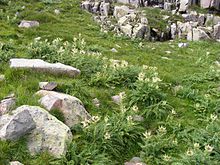Alpine thistle
| Alpine thistle | ||||||||||||
|---|---|---|---|---|---|---|---|---|---|---|---|---|

Alpine thistle ( Cirsium spinosissimum ) |
||||||||||||
| Systematics | ||||||||||||
|
||||||||||||
| Scientific name | ||||||||||||
| Cirsium spinosissimum | ||||||||||||
| ( L. ) Scop. |
The Alpine thistle ( Cirsium spinosissimum ) is a type of plant from the genus of the seared thistle ( Cirsium ) in the subfamily of the Carduoideae within the family of the Asteraceae . Other common names are Stachel-Kratzdistel , Vielstachel-Kratzdistel or Kratzigste Kratzdistel . Their botanical name Cirsium spinosissimum means thorniest of all thistles .
description
Vegetative characteristics
The perennial herbaceous plant reaches heights of 20 to 80 centimeters. It has protruding hair. The thick stem is mostly leafy along its entire length.
The stiff, stinging leaves are deeply cupped and deeply pinnately fissured with thorn-tooth sections. The lower leaves are stalked, the upper ones heart-shaped, encompassing stems.
Generative characteristics
The flowering period extends from July to September. There are usually two or more pale yellow flower heads heaped tightly together. The thorny serrated, white-yellowish bracts are 20 to 25 millimeters long and protrude above the flower heads. The tubular flowers are pale yellow.
The 3 to 5 millimeters large, brownish achenes have a pinnate pappus .
The number of chromosomes is 2n = 34.
ecology
The Alpine thistle is a mesomorphic, hygromorphic hemicryptophyte .
The visual effect of the accumulation of flower heads is enhanced by the long, pointed bracts and is visible from afar in the bare high alpine region. Butterflies, beetles and flies act as pollinators.

The Alpine thistle is an annoying “willow weed ” and is fought on alpine pastures. The adult plants are protected from cattle by the many thorns. Young flower heads are still eaten by small cattle.
Occurrence
The Alpine thistle is only found in the Alps . The distribution area extends from the Rhone eastwards across northern Italy , Switzerland and Germany to Lower Austria and Styria . Data for the Apennines relate to Bertoloni's scrub thistle ( Cirsium bertolonii Spreng. , Syn .: Cirsium spinosissimum subsp. Bertolonii (Spreng.) K. Werner ).
Common locations are fresh to moist Hochstaudenfluren , especially Bach edges, with nitrogen-rich soils in pastures, between boulders, on debris and warehouses hallways. It thrives at altitudes from 1100 to 3000 meters. The Alpine thistle is a characteristic species of the Peucedano-Cirsietum spinosissimi. In the Allgäu Alps, it rises in the Tyrolean part on the summit of the Hohe Licht to an altitude of 2600 meters.
The Alpine thistle is considered a nitrogen pointer and soil stabilizer. Pointer values according to Ellenberg are; L-7, T-2, K-5, F-6, R-7, N-8, S-0.
use
The thorny leaves are masterpieces of ornamentation and served as a template for brocade embroidery and Gothic ornamentation as early as the Middle Ages .
Young shoots are used as spinach or as an ingredient in spring herb soups. In some Alpine valleys, the plant was also cooked as pig feed.
Common names
For the Alpen-Kratzdiestel the other German-language trivial names exist or existed : Einhacken ( Tyrol near Lienz ) and Kraftwurz ( Berchtesgaden ).
literature
- Xaver Finkenzeller, Jürke Grau: Alpine flowers. Recognize and determine (= Steinbach's natural guide ). Mosaik, Munich 2002, ISBN 3-576-11482-3 .
- Manfred A. Fischer, Wolfgang Adler, Karl Oswald: Excursion flora for Austria, Liechtenstein and South Tyrol . 2nd, improved and enlarged edition. State of Upper Austria, Biology Center of the Upper Austrian State Museums, Linz 2005, ISBN 3-85474-140-5 .
- Herbert Sauerbier, Wolfgang Langer: Alpine plants - endemic from Nice to Vienna. IHW, Eching 2000, ISBN 3-930167-41-7 .
- Wendelberger: Alpine plants - flowers, grasses, dwarf shrubs (= spectrum of nature ). blv, Munich / Vienna / Zurich 1984, ISBN 3-405-12868-4 .
Individual evidence
- ↑ a b c Cirsium spinosissimum (L.) Scop., Alpen-Kratzdistel. In: FloraWeb.de.
- ↑ a b Erich Oberdorfer : Plant-sociological excursion flora for Germany and neighboring areas . With the collaboration of Angelika Schwabe and Theo Müller. 8th, heavily revised and expanded edition. Eugen Ulmer, Stuttgart (Hohenheim) 2001, ISBN 3-8001-3131-5 , pp. 966 .
- ↑ Erhard Dörr, Wolfgang Lippert : Flora of the Allgäu and its surroundings. Volume 2, IHW, Eching 2004, ISBN 3-930167-61-1 , p. 641.
- ^ Georg August Pritzel , Carl Jessen : The German folk names of plants. New contribution to the German linguistic treasure. Philipp Cohen, Hannover 1882, page 102. ( online ).
Web links
- Cirsium spinosissimum subsp. spinosissimum (L.) Scop., Alpine thistle (subspecies). In: FloraWeb.de.
- Alpine thistle . In: BiolFlor, the database of biological-ecological characteristics of the flora of Germany.
- Profile and distribution map for Bavaria . In: Botanical Information Hub of Bavaria .
- Cirsium spinosissimum (L.) Scop. In: Info Flora , the national data and information center for Swiss flora . Retrieved June 15, 2016.
- Thomas Meyer: Kratzdistel data sheet with identification key and photos at Flora-de: Flora von Deutschland (old name of the website: Flowers in Swabia ).

